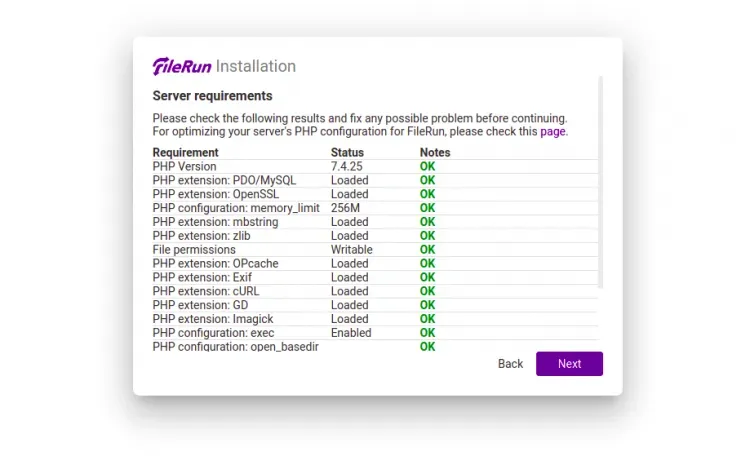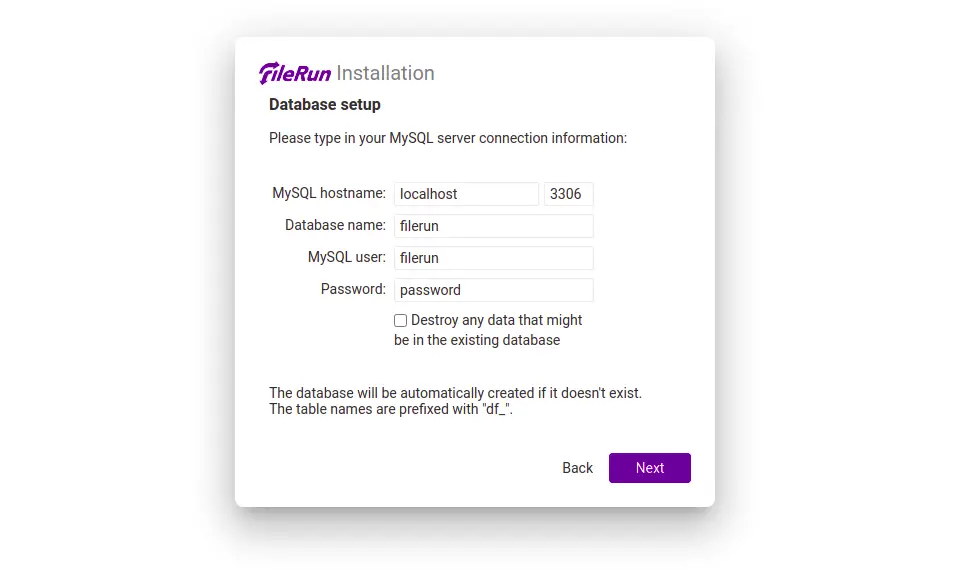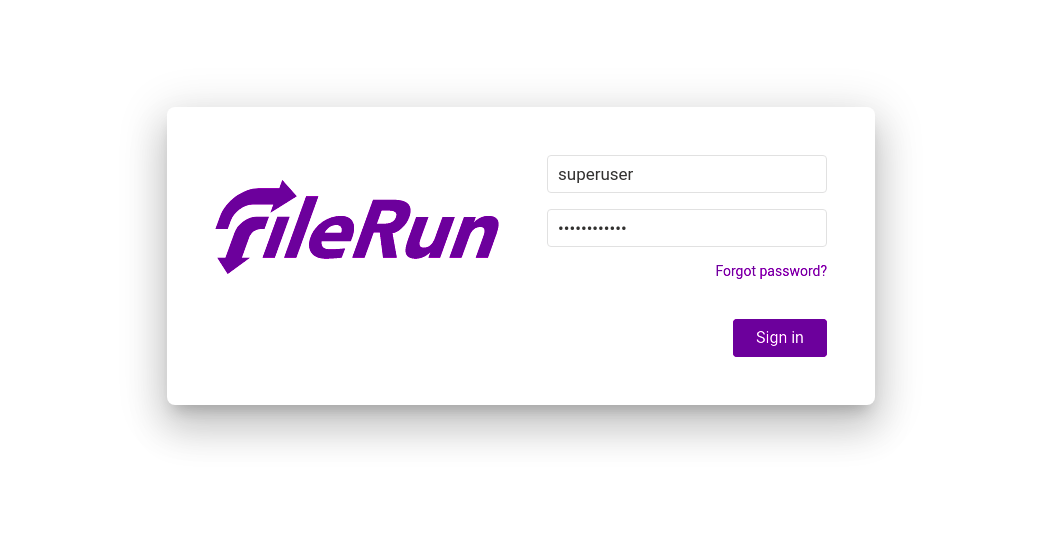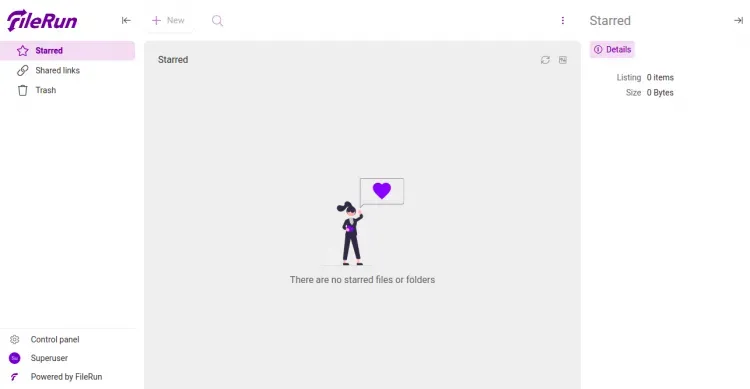Introduzione
FileRun è un'applicazione di condivisione file gratuita, open source e self-hosted per Linux. È un'ottima alternativa a Google Drive e Dropbox. Ti consente di condividere e sincronizzare file, accedere tramite WebDAV e persino collegarti ad esso con l'app mobile Nextcloud. È scritto in PHP e utilizza MariaDB come backend del database. Ti consente di accedere ai tuoi file ovunque tramite un cloud storage sicuro e offre anche il backup e la condivisione di foto, video, file e altro ancora.
In questo articolo spiegherò come installare FileRun con Apache e Let's Encrypt SSL su Debian 11.
Se desideri installare FileRun su un server in remoto continua a leggere, altrimenti salta il primo paragrafo "Connessione al Server" e leggi il successivo.
Connessione al Server
Per accedere al server, è necessario conoscere l'indirizzo IP. Avrai anche bisogno dell'username e della password per l'autenticazione. Per connettersi al server come utente root digitare il seguente comando:
ssh root@IP_DEL_SERVERSuccessivamente sarà necessario inserire la password dell'utente root.
Se non utilizzate l'utente root potete connettervi con un'altro nome utente utilizzando lo stesso comando, quindi modificare root con il vostro nome_utente:
ssh nome_utente@IP_DEL_SERVERSuccessivamente vi verrà chiesto di inserire la password del vostro utente.
La porta standard per connettersi tramite ssh è la 22, se il vostro server utilizza una porta diversa, sarà necessario specificarla utilizzando il parametro -p, quindi digitare il seguente comando:
ssh nome_utente@IP_DEL_SERVER -p PORTAPrerequisiti
- Un server che esegue Debian 11.
- Un nome di dominio valido puntato con l'IP del tuo server.
- Una password di root è configurata sul server.
Installare il server LAMP
Innanzitutto, dovrai installare Apache, MariaDB, PHP e altri pacchetti sul tuo server. Puoi installarli tutti eseguendo il seguente comando:
apt-get install apache2 mariadb-server mariadb-client php libapache2-mod-php imagemagick ffmpeg php-imagick php-mysql php-fpm php-common php-gd php-json php-curl php-zip php-xml php-mbstring php-bz2 php-intl unzip -yUna volta installati tutti i pacchetti, dovrai installare anche il caricatore IonCube sul tuo sistema.
Innanzitutto, scarica il caricatore IonCube con il seguente comando:
wget https://downloads.ioncube.com/loader_downloads/ioncube_loaders_lin_x86-64.tar.gzUna volta completato il download, estrai il file scaricato con il seguente comando:
tar -xzf ioncube_loaders_lin_x86-64.tar.gz -C /usr/lib/phpQuindi, crea un file di configurazione di ioncube e definisci il percorso della sorgente di IonCube:
nano /etc/php/7.4/apache2/conf.d/00-ioncube.iniAggiungi la seguente riga:
zend_extension = /usr/lib/php/ioncube/ioncube_loader_lin_7.4.soSalva e chiudi il file, quindi crea un file di configurazione PHP per FileRun:
nano /etc/php/7.4/apache2/conf.d/filerun.iniAggiungi le seguenti impostazioni:
expose_php = Off
error_reporting = E_ALL & ~E_NOTICE
display_errors = Off
display_startup_errors = Off
log_errors = On
ignore_repeated_errors = Off
allow_url_fopen = On
allow_url_include = Off
variables_order = "GPCS"
allow_webdav_methods = On
memory_limit = 128M
max_execution_time = 300
output_buffering = Off
output_handler = ""
zlib.output_compression = Off
zlib.output_handler = ""
safe_mode = Off
register_globals = Off
magic_quotes_gpc = Off
upload_max_filesize = 20M
post_max_size = 20M
enable_dl = Off
disable_functions = ""
disable_classes = ""
session.save_handler = files
session.use_cookies = 1
session.use_only_cookies = 1
session.auto_start = 0
session.cookie_lifetime = 0
session.cookie_httponly = 1
date.timezone = "UTC"Salva e chiudi il file, quindi riavvia il servizio Apache per applicare le modifiche:
systemctl reload apache2Configurare il database MariaDB
Innanzitutto, dovrai proteggere l'installazione di MariaDB usando il seguente comando:
mysql_secure_installationRispondi a tutte le domande come mostrato di seguito:
Enter current password for root (enter for none): PRESS ENTER
Set root password? [Y/n] Y
New password:
Re-enter new password:
Remove anonymous users? [Y/n] Y
Disallow root login remotely? [Y/n] Y
Remove test database and access to it? [Y/n] Y
Reload privilege tables now? [Y/n] YQuindi, accedi alla shell MariaDB con il seguente comando:
mysql -u root -pUna volta effettuato l'accesso, creare un database e un utente con il seguente comando:
CREATE DATABASE filerun;GRANT ALL PRIVILEGES ON filerun.* TO 'filerun'@'localhost';Quindi, concedi tutti i privilegi al database FileRun con il seguente comando:
GRANT ALL PRIVILEGES ON filerun.* TO 'filerun'@'localhost';Quindi, svuota i privilegi ed esci da MariaDB con il seguente comando:
FLUSH PRIVILEGES;EXIT;Una volta terminato, puoi procedere al passaggio successivo.
Scaricare FileRun
Innanzitutto, scarica l'ultima versione di FileRun con il seguente comando:
wget -O FileRun.zip https://filerun.com/download-latestUna volta scaricato FileRun, decomprimere il file scaricato utilizzando il seguente comando:
unzip FileRun.zip -d /var/www/html/filerun/Quindi, imposta l'autorizzazione e la proprietà appropriate con il comando seguente:
chown -R www-data:www-data /var/www/html/filerunchmod -R 755 /var/www/html/filerunUna volta terminato, puoi procedere al passaggio successivo.
Configurare Apache per FileRun
Successivamente, dovrai creare un file di configurazione dell'host virtuale Apache per FileRun. Puoi crearlo con il seguente comando:
nano /etc/apache2/sites-available/filerun.confAggiungi le seguenti righe:
<VirtualHost *:80>
ServerName filerun.example.com
DocumentRoot /var/www/html/filerun
<Directory "/var/www/html/filerun">
Options Indexes FollowSymLinks
AllowOverride All
Require all granted
</Directory>
ErrorLog ${APACHE_LOG_DIR}/filerun.error.log
CustomLog ${APACHE_LOG_DIR}/filerun.access.log combined
</VirtualHost>Salva e chiudi il file quindi attiva l'host virtuale Apache e riscrivi il modulo con il seguente comando:
a2ensite filerun.confa2enmod rewriteQuindi, riavvia il servizio Apache per applicare le modifiche:
systemctl restart apache2Puoi anche controllare lo stato di Apache con il seguente comando:
systemctl status apache2Dovresti vedere il seguente output:
? apache2.service - The Apache HTTP Server
Loaded: loaded (/lib/systemd/system/apache2.service; enabled; vendor preset: enabled)
Active: active (running) since Sat 2022-01-29 15:14:56 UTC; 5s ago
Docs: https://httpd.apache.org/docs/2.4/
Process: 22533 ExecStart=/usr/sbin/apachectl start (code=exited, status=0/SUCCESS)
Main PID: 22538 (apache2)
Tasks: 6 (limit: 2341)
Memory: 16.4M
CPU: 94ms
CGroup: /system.slice/apache2.service
??22538 /usr/sbin/apache2 -k start
??22539 /usr/sbin/apache2 -k start
??22540 /usr/sbin/apache2 -k start
??22541 /usr/sbin/apache2 -k start
??22542 /usr/sbin/apache2 -k start
??22543 /usr/sbin/apache2 -k start
Jan 29 15:14:56 debian11 systemd[1]: Starting The Apache HTTP Server...Una volta terminato, puoi procedere al passaggio successivo.
Accedere all'interfaccia utente Web di FileRun
Ora apri il tuo browser web e accedi all'interfaccia utente web di FileRun utilizzando l'URL http://filerun.example.com.

Fare clic sul pulsante Avanti. dovresti vedere la pagina di controllo dei requisiti del server.

Fare clic sul pulsante Avanti. Dovresti vedere la pagina di configurazione del database.

Fare clic sul pulsante Avanti. Una volta terminata l'installazione.
Fare clic sul pulsante Avanti. Dovresti vedere la pagina di accesso di FileRun.

Fornisci il nome utente e la password dell'amministratore e fai clic sul pulsante Accedi. Dovresti vedere la dashboard di FileRun.

Secure FileRun con Let's Encrypt SSL
Si consiglia inoltre di proteggere il tuo sito Web con Let's Encrypt SSL. Innanzitutto, dovrai installare il client Certbot per installare e gestire SSL. Per impostazione predefinita, il pacchetto Certbot è incluso nel repository predefinito di Debian, quindi puoi installarlo con il seguente comando:
apt-get install python3-certbot-apache -yUna volta installato Certbot, esegui il comando seguente per proteggere il tuo sito Web con Let's Encrypt SSL:
certbot --apache -d filerun.example.comTi verrà chiesto di fornire la tua email e di accettare i termini del servizio come mostrato di seguito:
Saving debug log to /var/log/letsencrypt/letsencrypt.log
Plugins selected: Authenticator standalone, Installer None
Enter email address (used for urgent renewal and security notices) (Enter 'c' to
cancel): hitjethva1981@gmail.com
- - - - - - - - - - - - - - - - - - - - - - - - - - - - - - - - - - - - - - - -
Please read the Terms of Service at
https://letsencrypt.org/documents/LE-SA-v1.2-November-15-2017.pdf. You must
agree in order to register with the ACME server at
https://acme-v02.api.letsencrypt.org/directory
- - - - - - - - - - - - - - - - - - - - - - - - - - - - - - - - - - - - - - - -
(A)gree/(C)ancel: A
- - - - - - - - - - - - - - - - - - - - - - - - - - - - - - - - - - - - - - - -
Would you be willing to share your email address with the Electronic Frontier
Foundation, a founding partner of the Let's Encrypt project and the non-profit
organization that develops Certbot? We'd like to send you email about our work
encrypting the web, EFF news, campaigns, and ways to support digital freedom.
- - - - - - - - - - - - - - - - - - - - - - - - - - - - - - - - - - - - - - - -
(Y)es/(N)o: Y
Plugins selected: Authenticator apache, Installer apache
Obtaining a new certificate
Performing the following challenges:
http-01 challenge for filerun.example.com
Enabled Apache rewrite module
Waiting for verification...
Cleaning up challenges
Created an SSL vhost at /etc/apache2/sites-available/filerun-le-ssl.conf
Enabled Apache socache_shmcb module
Enabled Apache ssl module
Deploying Certificate to VirtualHost /etc/apache2/sites-available/filerun-le-ssl.conf
Enabling available site: /etc/apache2/sites-available/filerun-le-ssl.conf
Next, select whether or not to redirect HTTP traffic to HTTPS as shown below:Scegli se reindirizzare o meno il traffico HTTP su HTTPS, rimuovendo l'accesso HTTP.
- - - - - - - - - - - - - - - - - - - - - - - - - - - - - - - - - - - - - - - -
1: No redirect - Make no further changes to the webserver configuration.
2: Redirect - Make all requests redirect to secure HTTPS access. Choose this for
new sites, or if you're confident your site works on HTTPS. You can undo this
change by editing your web server's configuration.
- - - - - - - - - - - - - - - - - - - - - - - - - - - - - - - - - - - - - - - -
Select the appropriate number [1-2] then [enter] (press 'c' to cancel): 2Digita 2 e premi Invio per installare Let's Encrypt SSL per il tuo sito web:
- - - - - - - - - - - - - - - - - - - - - - - - - - - - - - - - - - - - - - - -
1: No redirect - Make no further changes to the webserver configuration.
2: Redirect - Make all requests redirect to secure HTTPS access. Choose this for
new sites, or if you're confident your site works on HTTPS. You can undo this
change by editing your web server's configuration.
- - - - - - - - - - - - - - - - - - - - - - - - - - - - - - - - - - - - - - - -
Select the appropriate number [1-2] then [enter] (press 'c' to cancel): 2Conclusione
Congratulazioni! hai installato con successo FileRun con Apache e Let's Encrypt SSL su Debian 11. Ora puoi usare FileRun per archiviare file, musica, foto e condividerli con amici e familiari.

